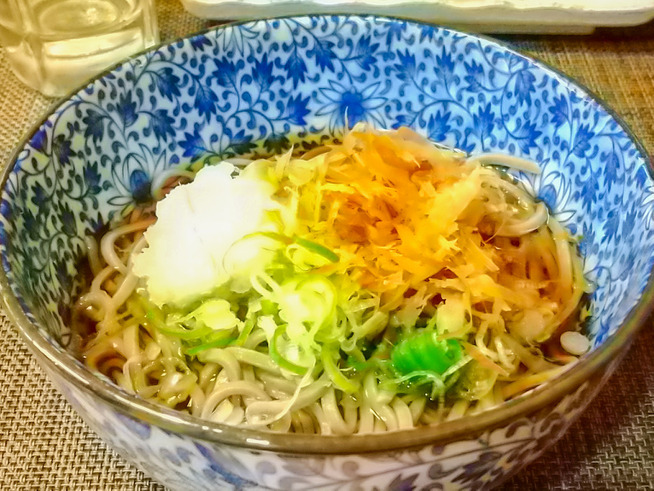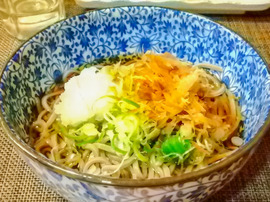
Echizen Soba Noodles

FukuiEchizen Soba Noodles
Classification (Large)
Agricultural products
Classification (Small)
Grain products
Main ingredients used
Soba noodles
When using downloaded images, please read the "Terms of Use" and clearly state that the source of the image is "Traditional Foods in Japan" by the Ministry of Agriculture, Forestry and Fisheries.
If the photo credits is stated, please include it as well.
Example of description
of the photo credits
Example of description when the photo credits is not stated
Source: "Traditional Foods in Japan" Ministry of Agriculture, Forestry and Fisheries
Example of description when the photo credits is stated
Source: "Traditional Foods in Japan" Ministry of Agriculture, Forestry and Fisheries
Photo credits:xxx
Region of inheritance
All regions of Fukui Prefecture
Product overview (special characteristics and types)
Fukui Prefecture cultivates a great amount of buckwheat that is native to the area. As of 2021, there are 22 native species of buckwheat that are archived at the Fukui Prefecture Processed Foods Research Center. Some of the prominent native species of buckwheat include the Ono, the Maruoka, the Imajo, and the Miyama Minami-miyachi. Each of these species are grown in specific climates within the prefecture and through the manufacturers’ different cultivation methods their tastes develop into something unique, instead of uniform. As a whole, although the buckwheat grains are small, they have a rich taste and a superior fragrance — that is the distinguishing feature of Fukui Prefecture’s buckwheat.
The soba noodles produced from premium-quality brown buckwheat enjoy a good reputation due to their flavor and sweetness. Even though it is eaten regularly today, it used to be a famine food called “sobagaki,” made by adding hot water to buckwheat flour and kneading. The noodle form was most often eaten as a dish for special occasions.
History and culture
The cultivation of buckwheat in Fukui Prefecture dates back to 1471, when Sengoku period daimyo Asakura Takakage built his castle in Ichijodani Valley and, in the time between battles, grew buckwheat that could be harvested quickly (approximately within 75 days) and be used as food during sieges. The buckwheat of that time was not made into noodles but into buckwheat flour, which was mixed with hot water and kneaded to form “sobagaki” and “sobadango.” The noodle form only made its debut in 1601. Honda Tomimasa, the castle lord of Fuchu (present-day Echizen City), took along soba noodle chefs from Kyoto-Fushimi, and that was how the dish of thin strips of soba noodles topped with grated daikon radish — “oroshisoba” — was created. Today, it is a local specialty that represents the prefecture, being served in numerous restaurants and enjoying great popularity.
Production method
To make the most of the flavor of buckwheat, every miller in the prefecture processes Echizen Soba Noodle buckwheat flour with a millstone. Processing flour with a millstone isn’t time-efficient, but since the buckwheat is ground slowly, heat isn’t produced, which means the flavor and sweetness of the buckwheat isn’t affected by a change in temperature. Moreover, due to the fibres in the buckwheat not breaking down, the buckwheat flour turns out more glutinous. A distinguishing feature of Echizen Soba Noodles is their darker color, and they are well-known for their sweetness and strong aroma. This is thought to be the result of a grinding method called “hikigurumi,” where the chaff of the brown buckwheat is also milled together with the rest of the grain.
Conservation and succession efforts
There are many Echizen Soba Noodle restaurants in Fukui Prefecture, and they receive visitors from outside the prefecture as well. Harvest time for buckwheat is in November, and that is when the “New Buckwheat Festival” is held throughout the prefecture. This buckwheat culture is passed down in various ways, including competitions to decide who has Japan’s number one amateur soba noodle-making skills, high school students in the prefecture competing to prove who the real noodle-making champion is, and hands-on workshops that teach people how to make the noodles.
Main consumption method
Echizen Soba Noodles are boiled, then soaked in water to firm them up. Tsuyu (a thin, Japanese dipping sauce/soup base) is poured over the noodles and grated daikon radish (or spicy daikon radish, depending on the season), katsuobushi, or Japanese leeks are used as toppings in the distinguishing style of consumption, the “Echizen oroshisoba” style. Other than dipping the noodles in tsuyu, Echizen Soba Noodles are also eaten in a unique manner: by pouring the tsuyu over the noodles. In recent years, the buckwheat flour has also been increasingly used as galette flour and in desserts.
At-home recipes:Oroshi Soba Noodles(Ingredients Serves 4)
Ingredients
Uncooked soba noodles
4 portions
Daikon radish
400 g
Dashi stock
3 cups
Cooking wine
1 ⅓ tbsp
Mirin
1 ⅓ tbsp
Light soy sauce
slightly under 3 tbsp
Chopped Japanese leeks
20 g
Bonito flakes
8 g
How to make
Pour dashi stock into a pot and bring to a boil. Add cooking wine, soy sauce, and mirin to make soup for the noodles.
In a large pot of hot water, blanch the soba noodles, remove excess water, and move to a warmed container. (When cooling in water, thoroughly wash off any starchiness.)
In a bowl for kneading soba noodles, place the noodles from Step 2. Pour in the soup to which grated daikon radish has been added. Top with Japanese leeks and bonito flakes. Sprinkle chilies to taste.
There are three ways to enjoy this dish: pouring in soup that already has daikon radish added, adding the daikon radish and soup to the noodles separately, or adding the juices from the grated daikon radish to the soup before it is poured over.
Recipe credit : Fukui Prefectural Health Policy Division, Fukui Prefectural Dietary Improvement Promotion Committee: “Hotto suru ne — the Taste of Home”

